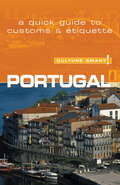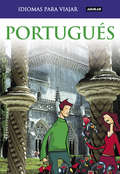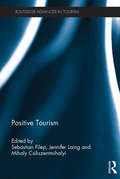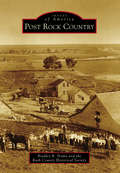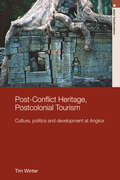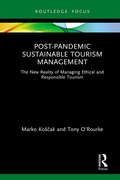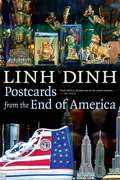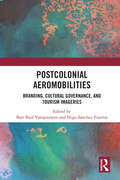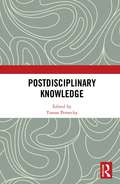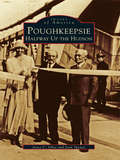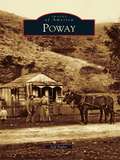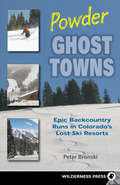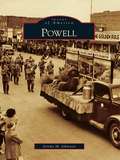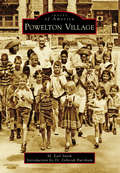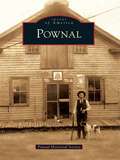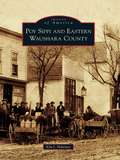- Table View
- List View
Portugal - Culture Smart!: The Essential Guide to Customs & Culture
by Sandy Guedes de QueirozAvoid being offended, or worse offending Portugal locals, instead familiarise yourself with local customs and cultures by reading Culture Smart! Portugal. This handy, pocket-sized book will help you to ease your way into a different culture and will assist you in making sure you don't develop incorrect stereotypes. Good preparation can go a long way in readying yourself for your journey. Whether you are setting off to Portugal in order to travel, learn, work or relocate, Culture Smart! will provide you with a wealth of information on everything from climate, population, doing business, nightlife and so much more. Culture Smart! Portugal offers an in-depth insight to the customs and cultures of Portugal, an area where many other guidebooks only scratch the surface.
Portugués (Idiomas para viajar #Volumen)
by El País-AguilarViajar no es sólo conocer nuevos lugares sino también intercambiar información y experiencias con quienes viven en ellos. Por eso esta es... LA GUÍA IMPRESCINDIBLE PARA COMUNICARSE EN SU VIAJE Idiomas para viajar ofrece ahora unos contenidos mucho más amplios y completos. Cada guía recoge todo lo que se necesita para desenvolverse durante el viaje: una guía de pronunciación, un resumen gramatical y un manual básico del idioma como introducción a todos los bloques temáticos pensados para resolver situaciones según avanza el viaje (llegada, desplazamientos, alojamiento, restaurantes, ocio, compras, salud, emergencias...). Un código de colores distingue los diferentes bloques temáticos para facilitar la consulta. Todos los capítulos tienen, además de introducciones prácticas del país, un vocabulario imprescindible y expresiones habituales, con sus correspondientes transcripciones. La guía concluye con un nuevo diccionario bilingüe, que contiene todas las palabras de uso habitual en la comunicación diaria. El idioma: Guía de pronunciación y gramática. El portugués imprescindible: Vocabulario y expresiones básicas. Llegada y desplazamientos: Para moverse por el país Alojamiento: En el hotel, en el camping, con niños... En el restaurante: Platos, productos, frases útiles... Ocio y compras: visitas, tiempo libre, comercios... Guía práctica: Servicios, salud, emergencias... Minidiccionarios: español-portugués, portugués-español
Positive Tourism (Routledge Advances in Tourism)
by Mihaly Csikszentmihalyi Jennifer Laing Sebastian FilepTourism affects millions of individuals, numerous societies and environments in multiple, nuanced and overlapping ways. While it can be viewed as a frivolous leisure pursuit or simply a large industry, with potentially destructive impacts, it might also be understood in terms of its effects on human fulfilment, the good life and greater well-being. This book calls for positive tourism, principally grounded in theories from positive psychology (the study of what makes life worth living), and the development of a body of knowledge that explains what characterises optimal tourist experiences, what enables host communities to flourish and what encourages workers in tourism to thrive. Through original research studies reported in this international volume we aim to further develop this knowledge. The intersections between ongoing and traditionally inspired applications of psychology in tourism and this new thrust in psychological inquiry promise to refresh and challenge tourism research. This book will appeal to researchers and academics in tourism, leisure, positive psychology, management and related fields as well as graduate students, professionals and policy makers.
Post Pandemic Facilitation of Air Transport: LEGAL, POLITICAL AND ECONOMIC ASPECTS
by Ruwantissa AbeyratneFrom early 2020 for a period of two years at the end of which this book was written, air transport suffered unprecedented setbacks due to the COVID-19 pandemic. Although the pandemic may eventually fizzle out into another flu like occurrence, the restraint with which air transport services were offered would remain with us for a while with some practices being sustained, particularly those pertaining to public health. One of the main areas of air transport that was and will be affected significantly by the changed circumstances - is facilitation – a subject that is regulated by the Chicago Convention of 1944 and its Annex 9. This book looks in depth at the Annex as it will be applied in a post pandemic world, against its legal, socio-political, and economic impacts, addressing the Standards of the Annex on clearance of aircraft; entry and departure of passengers; and the carriage of cargo. It also discusses some critical aviation events in 2020 and 2021 that occurred as they relate to facilitation of air transport. Some of the key areas discussed are the role of ICAO; issues of public health as they relate to air transport; security of travel documents; smuggling of persons; digital technology and rights of the passenger; unruly passengers; carriage of disabled passengers; relief flights and repatriation flights; and facilities at airports.
Post Rock Country (Images of America)
by Rush County Historical Society Bradley R. PenkaRush County, at the south end of Post Rock Country, was organized on December 5, 1874, and named in honor of Capt. Alexander Rush, Company H, of the 2nd Kansas Colored Infantry. The first settlers arrived in 1869 and established homesteads along Walnut Creek near the Fort Hays-Fort Dodge Trail. With few trees on the vast, dry prairie, settlers searched for alternative building materials. Post Rock, a unique limestone bed that sat within inches of the surface, was so well used and became such a curiosity that it gave rise to the Post Rock Museum in 1963.
Post-Conflict Heritage, Postcolonial Tourism: Tourism, Politics and Development at Angkor (Routledge Studies in Asia's Transformations)
by Tim WinterAngkor, Cambodia’s only World Heritage Site, is enduring one of the most crucial, turbulent periods in its twelve hundred year history. Given Cambodia’s need to restore its shattered social and physical infrastructures after decades of violent conflict, and with tourism to Angkor increasing by a staggering 10,000 per cent in just over a decade, the site has become an intense focal point of competing agendas. Angkor’s immense historical importance, along with its global prestige, has led to an unprecedented influx of aid, with over twenty countries together donating millions of dollars for conservation and research. For the Royal Government however, Angkor has become a ‘cash-cow’ of development. Post-conflict Heritage, Postcolonial Tourism critically examines this situation and locates Angkor within the broader contexts of post-conflict reconstruction, nation building, and socio-economic rehabilitation. Based on two years of fieldwork, the book explores culture, development, the politics of space, and the relationship between consumption, memory and identity to reveal the aspirations and tensions, anxieties and paradoxical agendas, which form around a heritage tourism landscape in a post-conflict, postcolonial society. With the situation in Cambodia examined as a stark example of a phenomenon common to many countries attempting to recover after periods of war or political turmoil, Post-conflict Heritage, Postcolonial Tourism will be of particular interest to students and scholars working in the fields of Asian studies, tourism, heritage, development, and cultural and postcolonial studies.
Post-Pandemic Sustainable Tourism Management: The New Reality of Managing Ethical and Responsible Tourism (Routledge Focus on Environment and Sustainability)
by Tony O’Rourke Marko KoščakTourism, as with many parts of the economy, is at a pause-reflect-rest stage in the post pandemic world. This book puts forward some positive and practical concepts for the reset stage in terms of pushing towards wholly sustainable tourism. The COVID-19 pandemic has been disastrous in terms of the loss of human life, the physical and mental strains placed on large numbers of populations across the globe who have been quarantined in their homes and in terms of the costs of dealing with the pandemic and supporting business and citizens through the period. Tourism has been comprehensively damaged, not only in advanced economies, but also in poorer developing economies where tourism provides a vital source of income and employment. The problem has been complicated by the shattering effect on mass tourism, which has been far more sensitive to the shutdown of travel and accommodation than ethical and responsible tourism activities focused at a local sustainable level. Therefore this book evaluates how the pandemic and economic decline affects ethical and responsible tourism - the type of tourism which sustains and develops local communities in a balanced way for the benefit of future generations. It reflects on the position the authors established in "Ethical & Responsible Tourism - managing sustainability in local tourism destinations" and then determines how ethically and responsibly focused tourism may adapt, develop and maintain safety for consumers in the post-virus world. This book will be essential reading for students, researchers and practitioners of tourism, environmental and sustainability studies.
Postcards from the End of America
by Linh DinhRoaming the country by bus and train, on a budget and without any institutional support, Linh Dinh set out to document, in words and pictures, what life is like for people. From Los Angeles, Cheyenne, Portland, and New Orleans, to Jackson and Wolf Point--Linh walked miles and miles through unfamiliar neighborhoods, talking to whoever would talk to him: the homeless living in tent cities, the peddlers, the protestors, the public preachers, the prostitutes. With the uncompromising eye of a Walker Evans or a Dorothea Lange, and the indomitable, forthright prose of a modern-day Nelson Algren or James Agee, Dinh documents the appalling and the absurd with warmth and honesty, giving voice to America's often forgotten citizens and championing the awesome strength it takes to survive for those on the bottom. Growing out of a photo and political writing blog Linh has maintained since 2009, Postcards from the End of America is an unflinching diary of what Linh sees as the accelerating collapse of America. Tracking the economic, political, and social unraveling--from the casinos to the abandoned factories and over all the sidewalks in between--with a poet's incisive tongue, Linh shows us the uncanny power of the people in the face of societal devastation.
Postcards to Europe: The unique must-have collection
by VariousThis is not a book about politics. It is a book about what makes us British, and what makes us European.Spend time with some of your favourite writers and artists in this truly unique collection spanning everything from art, language, food, music and movies, to war, literature, driving, nudity, geography, smoking and nature.Featuring pieces of exceptional quality from some of our most treasured novelists, historians, journalists, poets and artists, including: Jessie Burton, Richard Herring, Alain de Botton, Tom Bradby, Val McDermid, Matt Haig, Afua Hirsch, Lionel Shriver, Sarah Perry, Sanjeev Bhaskar, Ian Rankin, Owen Jones, Mark Kermode, Robert Macfarlane, Chris Riddell, Former Prime Minister Jim Hacker and many more.A must-read for anyone who wants to understand the times we live in, our relationship with the continent, and ourselves.* * * * *INCLUDES PIECES BY:Yasmin Alibhai-Brown, Sanjeev Bhaskar, Tom Bradby, Jessie Burton, Ben Collins (aka The Stig), Colonel Tim Collins, Robert Crampton, Adam Dant, Alain de Botton, Kate Eberlen, Matt Frei, Nicci French, Simon Garfield, Jonathan Lynn writing as Former Prime Minister Jim Hacker, Matt Haig, Richard Herring, Jennifer Higgie, Afua Hirsch, Owen Jones, Oliver Kamm, Alex Kapranos, Mark Kermode, Hari Kunzru, Olivia Laing, Marie Le Conte, Amy Liptrot, Robert Macfarlane, Henry Marsh, Val McDermid, Ian McEwan, Hollie McNish, Kate Mosse, Jenni Murray, Sarah Perry, Ian Rankin, Jacob Rees-Mogg, Cathy Rentzenbrink, Chris Riddell, Andrew Roberts, Will Self, David Shrigley, Lionel Shriver, Sunny Singh, Ece Temelkuran, Rob Temple, Bee Wilson, Sarah Winman
Postcolonial Aeromobilities: Branding, Cultural Governance, and Tourism Imageries
by Iñigo Sánchez-Fuarros Bart Paul VanspauwenThis edited collection explores how national airlines in postcolonial states operate at the complex intersection of corporate branding, cultural governance, tourism development, and national identity formation. It conceptualizes airplanes and airports as both tangible infrastructural spaces and symbolic domains that connect geographically distant regions while embodying aspirations of political sovereignty and cultural unity. Through diverse case studies spanning multiple continents, the book examines how commercial aviation's physical and cultural spaces either reinforce or challenge colonial histories and imperial legacies.The volume reveals how modern Western imperial narratives were shaped through specific cultural and social negotiations that played out in airline branding, route networks, service standards, and cultural policies. It analyzes how airlines serve as vehicles for projecting soft power and cultural diplomacy while mediating between local traditions and global modernity. Drawing on rich empirical examples from Angola, Argentina, Australia, Belgium, Brazil, Jamaica, Kenya, France, Hong Kong, Indonesia, Lebanon, Mexico, Peru, South Africa, Turkey, and the United States, this collection demonstrates how airlines employ sophisticated cultural management and corporate branding strategies to shape national and regional identities.By examining airlines as sites where business strategy, cultural policy, and identity politics intersect, this collection advances our understanding of how transportation infrastructure shapes social imaginaries and power relations in our increasingly connected yet culturally diverse world. The research has important implications for scholars of business history, cultural studies, postcolonial theory, and transportation geography while offering practical insights for policymakers and airline industry leaders.
Postcolonial Travel Writing
by Justin D. Edwards Rune GraulundWith its inclusion of original essays challenging the view of travel writing as a Eurocentric genre, this book will stand as a benchmark study of future inquiries in the field. It will revitalize the critical debate, sparking a much needed rethinking of a vibrant and highly popular but also volatile genre that has seen many changes in recent years.
Postdisciplinary Knowledge
by Tomas PerneckyPostdisciplinary Knowledge is the first book to articulate postdisciplinarity in philosophical, theoretical and methodological terms, helping to establish it as an important intellectual movement of the twenty-first century. It formulates what postdisciplinarity is, and how it can be implemented in research practice. The diverse chapters present a rich collection of highly creative thought-provoking essays and methodological insights. Written by a number of pioneering intellectuals with a range of backgrounds and research foci, these chapters cover a broad spectrum of areas demonstrating alternative ways of producing knowledge. Essays are interspersed with dialogue, encouraging a comprehensive and engaging discussion on this emerging movement. Not limited to a specific field or discipline, this will be of great interest to upper-level students and researchers in a wide range of subject areas, including: tourism, sociology, education, psychology, physiotherapy, fine arts, architecture and design, as well as those with a general interest in epistemology and methodology.
Pot Planet: Adventures in Global Marijuana Culture
by Brian Preston“A gimlet-eyed and often hilarious account of the author’s round-the-world reefer safari . . . A surprisingly clear-headed view of potheads worldwide” (The New Yorker). In Pot Planet, journalist Brian Preston sets out on a global ganja safari to explore strange new cannabis cultures, to seek out new growers, activists, and other reefer revolutionaries . . . and to boldly get baked with each of them. Preston’s journeys take him across every strata of pot cultivation and enjoyment. In the Canadian Kootenays, he meets hemp farmers struggling to harvest their crop on the fringes of legitimacy. In Cambodia and Morocco, he explores the final frontiers of Third World weed enthusiasts. In northern California, he takes a clear-eyed look at the medicinal marijuana movement, seeing both its promises and its problems. In England, Switzerland, and Spain, he observes grudging governments catching up to public tolerance. And at the Cannabis Cup in Amsterdam, he joins in the raucous multiday tasting competition and celebration at the international summit of the best breeders, growers, and connoisseurs in the world. Part investigative travelogue, part cultural history, part polemic for the unfettered enjoyment of nature’s most perfect and pleasing herb, Pot Planet is an unforgettable odyssey into the multifaceted world of hemp, full of wit, insight, and inspiration. “Fun to read, gallops along and, should you like to embark on such an odyssey yourself, might even serve as a guide . . . [or] an intoxicated mystery tour.” —Salon “A marvelously entertaining, well-written and probing look at the world though marijuana . . . Throughout, Preston proves himself to be both an intrepid traveler and a fine storyteller.” —Publishers Weekly
Potentials, Challenges and Prospects of Halal Tourism Development in Ethiopia (Routledge Insights in Tourism Series)
by Atilla Akbaba Mohammed Jemal AhmedThis book explores the potential of halal tourism development and its implementation in Ethiopia. The insights presented assist key stakeholders to make informed decisions concerning commercial strategy, profitability and feasibility of halal tourism from the secular perspective. This innovative book offers a unique contribution to halal tourism, being the first of its kind to assess halal tourism development in developing countries. It provides a clear understanding of what halal tourism means, how it has evolved and the current status of the industry. The book considers the prospects of halal tourism, including the conceptual and practical challenges of halal tourism development. The example of halal tourism in Ethiopia is explored to provide a lens through which deeper understandings can be drawn on where and how to develop halal tourism This book will be of interest to, researchers, students in the disciplines of tourism, anthropology, geography, business administration and sociology. It also provides useful insights for policy makers, planners and professionals in the hospitality and tourism industry.
Potrero Hill
by Peter Linenthal Abigail JohnstonA neighborhood in the southeast corner of San Francisco, Potrero Hill enjoys some of the city's finest weather and most spectacular views. Once pastureland and home to immigrants working in the shipbuilding industries, Potrero Hill was long ignored by guidebooks. Now "The Hill" is regenerating, and these pages highlight what is gone and what remains on these sunny slopes.
Poughkeepsie: Halfway Up the Hudson (Images of America)
by Joan Spence Joyce C. GheeFrom the colonial period, the Poughkeepsie area has been a prime location on the Hudson, midway between Albany and New York City. Accessibility, scenic beauty, and a dynamic economic and cultural environment have made both city and town of Poughkeepsie excellent communities in which to live, work, and play. Numerous Americans have left their mark here, including the Livingstons, S.F.B. Morse, the Smith Brothers (of cough drop fame), Matthew Vassar, Franklin and Eleanor Roosevelt, and Thomas Watson Sr. Poughkeepsie has also been enhanced by the contributions of its African American community and by successive waves of immigrants seeking a better life. From hosting New York's United States Constitutional Ratification Convention in 1788 to becoming the location of IBM during World War II, Poughkeepsie has continued to be the site of world-changing events.
Pouring A Round Of Pensacola's Past
by John D. Melvin, IIThe Oldest City in America and the Unfamiliar Stories Behind ItPensacola, Florida was a postbellum boomtown that offered the promise of prosperity to potential new-comers and long-time residents alike. Pouring A Round Of Pensacola's Past divulges the hidden past of a city steeped in mystery and local lore. From German immigrants to backwoods country folk, Pensacolians were as diverse as they were prosperous, with a penchant for alcohol production and consumption. The money flowed freely in Pensacola, and so too did the booze. But behind this facade of industry and revelry lay secrets of historical significance, secrets waiting to be uncovered.
Poway
by Jeff FiglerThe area that would become Poway was once the roaming grounds of the Diegueno and Luiseno Indians, several hundred years before the appearance of the Spaniards. It was also a pasturing place for mission stock, a ranch area for adventurous white settlers, a potential railroad stop that never materialized, and today is a diversified, thriving "city in the country" located within San Diego County. The story of Poway is one of many cultures, of many changes, and of many triumphs. Today it is a very desirable city in which to live, raise families, and send children to school; it is home to about 57,000 residents glad to have found the pleasures of living in Poway.
Powder Ghost Towns
by Peter BronskiIn its heyday, Colorado had more than 175 ski areas operating on the slopes of the Rocky Mountains, and while many of those resorts have shut down, their runs still shelter secret stashes of snow. Pristine slopes await backcountry powder hounds out to discover these chutes and steeps, bunny hills and bumps. Chronicling the history of more than 36 of these "lost resorts," Powder Ghost Towns provides the beta for how to ski and board these classic runs today, with comprehensive information on trailheads, where to skin up, and the best descents. Coverage ranges from southern Wyoming's Medicine Bow Mountains to the Colorado-New Mexico border, including famous old resorts like Hidden Valley in Rocky Mountain National Park.
Powell
by Jeremy M. JohnstonBy 1909, the completion of the Garland Canal brought water to the arid lands in the central Bighorn Basin, transforming the high plains desert into irrigated farmland. Homesteaders and businessmen poured into the region and established the town of Powell, named after famed government explorer John Wesley Powell. Residents of Powell worked through the years to overcome a variety of obstacles and establish a vibrant and lasting community that would continue to bloom in the arid landscape.
Powelton Village (Images of America)
by Dr Deborah Burnham M. Earl SmithFrom its humble beginnings as a strip of wilderness just west of William Penn's "greene country towne," Powelton Village has seen a rise in both prestige and activism since its inception in the late 17th century. An aristocratic estate at its founding, Powelton has found itself in a state of constant evolution, from the summer retreat of George Washington to the home of Pennsylvania's agricultural fair and from the playground of the elite to a hotbed of activism. In spite of, or because of, its mixed history, Powelton Village is unique among Philadelphia neighborhoods, both in its eclectic diversity and in its historic roots to the founding of the nation. Today, Powelton serves as a home to academics and their students, to the urban poor of Philadelphia, and to the elites of the University of Pennsylvania and Drexel University.
Power, Construction and Meaning in Festivals (Routledge Advances in Event Research Series)
by Alan Clarke Allan JepsonWhether through education, sport or festivity, events form the basis on which we attribute cultural meaning, significance and value to our lives. In this light, community events have the potential to create positive and negative social, cultural, economic and environmental impacts within the community across a wide variety of genres and platforms. This book offers a deeper and more critical insight into the relationships, dynamics and planning processes of festivals and events and the impact this has upon authenticity, cultural consumption and the local communities they serve. It does so by looking at a range of key debates in power theory, event planning and design, event construction, experience and meaning, authenticity, sustainability, social inclusion, accessibility and sponsorship engagement. International case studies are embedded within the chapters, examining the role of stakeholders, local communities, organisers, local governments and infrastructure. This critical event studies text is interdisciplinary and will make valuable reading for students and researchers who are interested in the relationships and dynamics involved in the construction and planning of festivals and events, their immediate impact and their significance for the future.
Power, Politics and International Events.: Socio-cultural Analyses of Festivals and Spectacles (Routledge Advances in Event Research Series)
by Udo MerkelAlthough the event management field has grown considerably over the last decade, critical, social-scientific studies of the international events industry are rare. This book intends to help fill this void. It focuses on power, social and political relations, conflicts and controversies in the context of international events, popular festivals and famous spectacles. It draws on recent primary research and offers a diverse range of new and intriguing case studies, for example the Arirang Festival in North Korea, the Gay Games, the Gymnaestrada, horse-racing events, the London 2012 Olympics, regional and rural festivals, the World Baseball Classic, World Fairs/Expos and U2 concerts. The main aim of this volume is to bring the critical, social-scientific analysis of events, festivals and spectacles more into the core of the teaching of events management degree programmes. The book draws extensively upon the disciplines of politics, sociology, cultural studies and history.In the process, it addresses key themes such as: • political economy• politics of popular culture• the global and the local• regionalism and globalization• nations and nationalism• international relations and foreign policy. This groundbreaking collection of essays is unique and innovative. It will be an essential source for students, researchers and academics with a keen interest in critical, social-scientific analyses of events.
Pownal (Images of America)
by Pownal Historical SocietyIn the 1700s, the fertile valley lands and wooded hills of Pownal attracted Dutch tenant farmers and English settlers. French Canadians soon arrived in the villages of Pownal to work in the mills, as both adults and children. Later painters and magazines captured the beauty of the land, while hill farmers struggled to make the thin soil produce. Following World War II, a United Nations magazine featured Pownal on its cover as a symbol of the peace so many sought. The photographs in Pownal illustrate the beauty, as well as hardships, associated with rural life. Vintage images of barefooted school students, farmers working their horses, and proud owners of the first automobiles capture the hardworking people of this Vermont community living amid a beauty that tourists seek.
Poy Sippi and Eastern Waushara County
by Kim J. HeltemesIn the early stages of Wisconsin's statehood, Vermonters settled in an area in east-central Wisconsin. Poy Sippi is a fine example of the pioneers' thirst for adventure, exploration, and hard work ethic. The lakes, creeks, and swamps did not impede this thirst. A small town nestled between two hills, Poy Sippi reminded the settlers of their eastern homes. The interaction of families within the neighboring communities brought about strong bonds and the development of eastern Waushara County. This is their story, told through vintage photographs.
